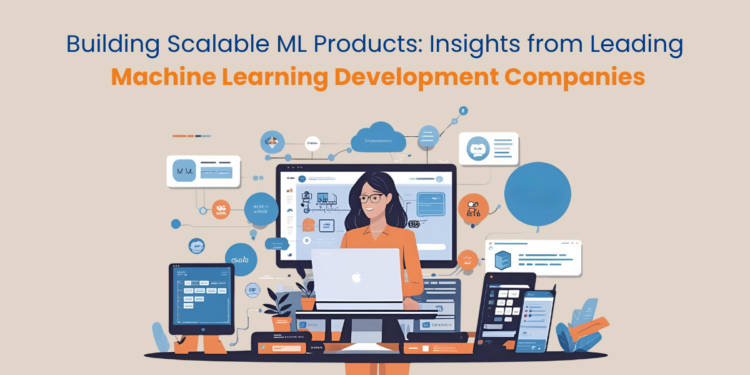In recent years, machine learning (ML) has transitioned from research labs into mainstream business applications. From recommendation engines and fraud detection to personalized user experiences and intelligent automation — ML is everywhere. But building an ML model in a controlled environment is one thing; scaling it to handle millions of users, changing datasets, and real-time decision-making is quite another.
This is where a machine learning development company plays a transformative role. These companies specialize in not just developing ML models but in ensuring they can scale, adapt, and perform reliably in production environments.
This blog dives deep into how leading ML development companies build scalable ML products, the challenges they face, strategies they use, and what you can learn from their playbooks.
Why Scalability Is Non-Negotiable in ML Product Development
ML solutions that aren’t built for scale often fail when deployed in real-world scenarios. Here’s why scalability is critical:
a. Accommodating User Growth
- As businesses grow, so does the number of users interacting with their ML-based systems.
- A model that works well for 1,000 users might crash or lag with 1 million users if not designed for scale.
b. Dealing with Evolving Data
- ML models are trained on historical data, but data patterns change.
- A scalable system should include mechanisms to detect concept drift and retrain or fine-tune models accordingly.
c. Real-Time Processing Needs
- Applications like autonomous vehicles, credit card fraud detection, and customer chatbots demand low-latency, high-availability systems.
- Scalability ensures models can process data streams in real time without bottlenecks.
d. Controlling Infrastructure Costs
- Unscalable systems often overuse computational resources, leading to bloated cloud bills.
- Optimizing infrastructure for scale ensures cost-efficiency and resource optimization.
Common Challenges in Building Scalable ML Products
Even advanced companies face roadblocks when scaling ML models. Here are some of the major ones:
a. Model Drift and Decay
- When the model’s accuracy diminishes over time due to changing data patterns.
- Without monitoring, this can go unnoticed and hurt user experience.
b. Feature Engineering Bottlenecks
- Inconsistent features between training and production environments often cause model underperformance.
- Managing and reusing features at scale is hard without a centralized feature store.
c. Infrastructure Fragility
- Poorly designed data pipelines or unoptimized models can crash under heavy load.
- Data ingestion and storage limits often throttle scalability.
d. Deployment Latency
- Complex models may take too long to serve predictions.
- Slow response times can degrade applications like real-time personalization or fraud detection.
e. Version Control and Retraining
- Managing multiple versions of a model across staging, shadow testing, and production can be difficult.
- Retraining pipelines must be automated to ensure continuous improvement.
Key Strategies from Leading Machine Learning Development Companies
Machine learning development companies follow well-defined strategies to overcome these hurdles and ensure scalable success:
a. Modular Architecture
- Why it matters: Breaks ML systems into independent units such as data processing, feature extraction, model training, and inference.
- Benefits: Enables parallel optimization, easier debugging, and independent scaling of components.
b. Microservices-Based ML Deployment
- Approach: Deploy ML models as microservices in Docker containers, orchestrated by Kubernetes.
- Benefits: Supports horizontal scaling, model version control, and quick rollback or updates.
c. MLOps and CI/CD Pipelines
- Tools used: MLflow, Kubeflow, GitHub Actions, Jenkins, and Vertex AI.
- Benefits: Automates the ML lifecycle — from training and testing to deployment and monitoring.
- Ensures reproducibility, faster release cycles, and fewer manual interventions.
d. Feature Stores
- Platforms: Tecton, Feast, Hopsworks.
- Why needed: Maintains consistency of features between training and inference.
- Advantages: Prevents training-serving skew and reduces redundant engineering.
e. Model Monitoring and Alerting
- Metrics Tracked: Accuracy, precision, recall, latency, input data distribution.
- Techniques: Drift detection, performance degradation alerts, shadow testing.
- Result: Proactive issue resolution before it impacts business operations.
Best Practices for Infrastructure and Deployment
To support scalable ML applications, robust infrastructure is crucial. Leading ML development companies rely on the following best practices:
1. Use Cloud-Native Platforms
- Examples: AWS SageMaker, Azure ML, GCP Vertex AI.
- Why: Offer built-in model training, deployment, and scalability features without infrastructure headaches.
2. Adopt Kubernetes and Auto-Scaling
- Deploy inference services in containers with Kubernetes for load balancing and auto-scaling.
- Use Helm charts to manage complex deployments.
3. Optimize Model Performance
- Reduce model size using:
- Quantization
- Pruning
- Knowledge distillation
- Improves speed and reduces memory usage.
4. Implement Shadow Testing
- Serve new models in parallel to the live model without affecting end-users.
- Helps compare outcomes and catch issues before full rollout.
5. Enable Model Versioning
- Store model metadata, version history, and performance metrics using tools like MLflow Tracking or DVC.
- Facilitates rollback and auditing.
Real-World Examples and Case Studies
Netflix
- Challenge: Scale personalized recommendations to 230+ million users.
- Solution: Modular ML systems, real-time data pipelines, scalable deployment with microservices.
- Result: Lightning-fast, personalized experiences that update in near real-time.
Spotify
- Challenge: Deliver real-time music recommendations to billions of streams.
- Approach: Built custom MLOps pipeline using TensorFlow Extended (TFX) and Kubernetes.
- Outcome: Faster model updates and 99.99% uptime.
Uber’s Michelangelo Platform
- Overview: End-to-end ML platform supporting thousands of models.
- Highlights: Supports training, deployment, monitoring, and A/B testing at scale.
- Impact: ML at the core of dynamic pricing, ETAs, fraud detection, and route optimization.
E-Commerce Startup Case Study
- Need: Real-time recommendation engine that could scale from 100K to 10M users.
- Partnered with: A machine learning development company for architecture and deployment.
- Solution: Used AWS Lambda for model serving, Redis for caching, and a custom feature store.
- Result: Achieved <200ms inference latency and 5x revenue lift from personalization.
Future Trends in Scalable Machine Learning Products
The future of ML scalability will be shaped by advanced technologies and evolving user needs. Watch for:
a. Serverless ML
- Run ML models in functions-as-a-service (FaaS) frameworks.
- Benefits: Instant scalability, reduced cost, and simpler infrastructure.
b. Edge Machine Learning
- Models deployed directly on edge devices like smartphones or IoT devices.
- Reduces latency and dependence on cloud — crucial for AR, robotics, and autonomous systems.
c. Federated Learning
- Trains models across multiple decentralized devices or servers without sharing data.
- Ideal for industries with privacy concerns like healthcare and finance.
d. AI Model Marketplaces
- Companies will increasingly use pre-trained and fine-tunable models from marketplaces (e.g., Hugging Face, AWS Marketplace).
- Accelerates time to deployment and reduces R&D efforts.
Conclusion
Building scalable machine learning products is no longer a nice-to-have; it’s a competitive necessity. The journey from data to a production-ready ML system involves more than just a great algorithm — it demands thoughtful infrastructure, rigorous processes, and smart automation.
That’s why businesses — from startups to enterprises — are partnering with machine learning development companies. These partners bring deep expertise in MLOps, scalable architectures, data engineering, and cloud infrastructure to help transform your ML prototype into a resilient, high-performance product.
Whether you’re planning a real-time chatbot, recommendation engine, or predictive analytics platform, building for scale from day one is essential — and achievable with the right guidance.
FAQs
Q1. What does it mean to build a scalable ML product?
It means designing a machine learning system that can maintain its performance and reliability as data volume, users, or prediction requests grow over time.
Q2. Why is scalability important in ML applications?
Without scalability, ML systems break down under load, become expensive, or fail to deliver accurate results — especially in production environments.
Q3. What role does a machine learning development company play?
They provide expertise in building, training, deploying, and monitoring ML systems — ensuring the solution is robust, scalable, and aligned with your business goals.
Q4. What tools help in building scalable ML products?
Popular tools include Kubernetes, MLflow, TensorFlow Extended, SageMaker, Vertex AI, Redis, and Tecton for feature management.
Q5. Can small businesses build scalable ML solutions?
Yes. By leveraging cloud-native tools and partnering with experienced development companies, even startups can build scalable, enterprise-grade ML systems cost-effectively.












